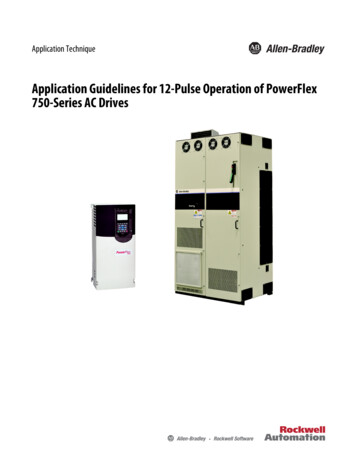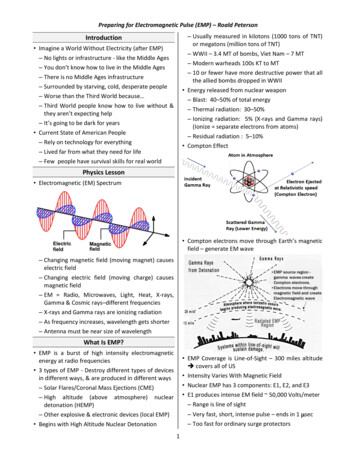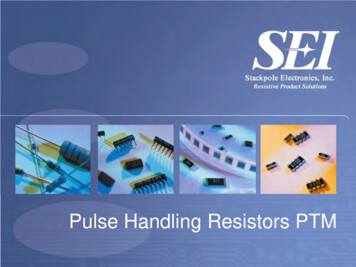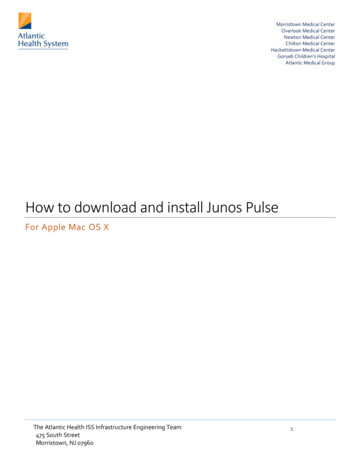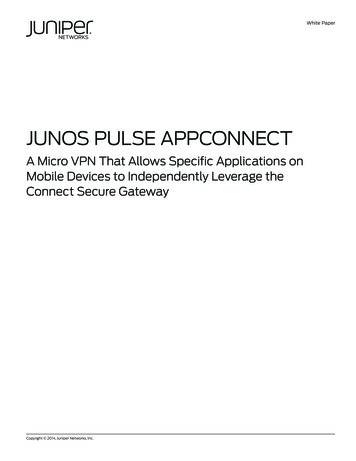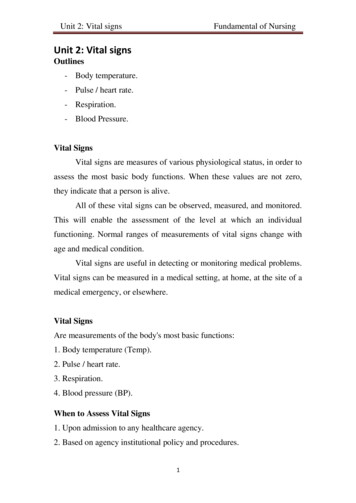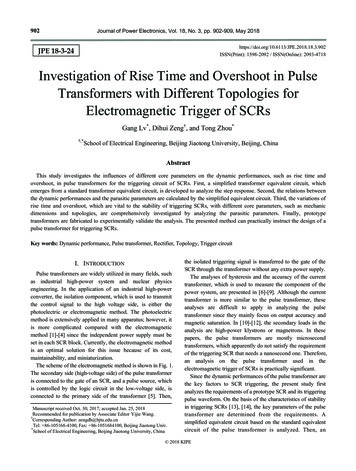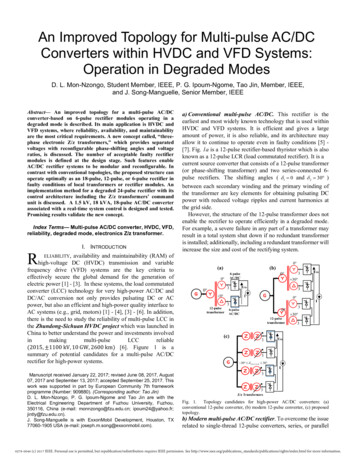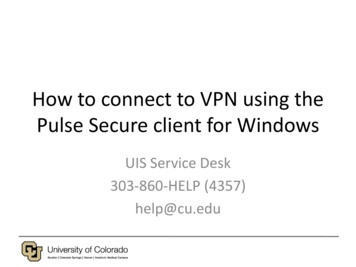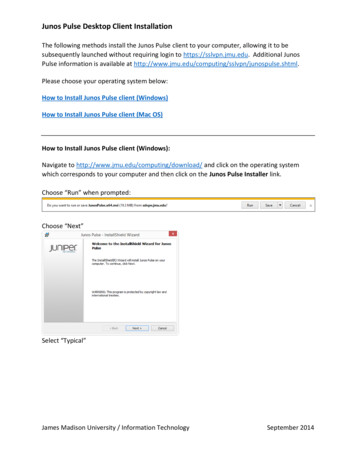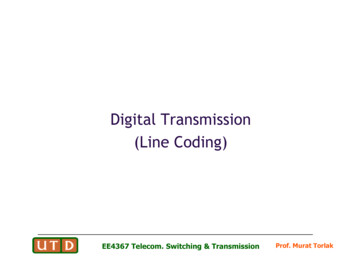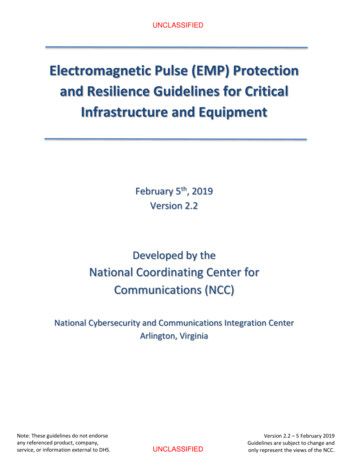
Transcription
UNCLASSIFIEDElectromagnetic Pulse (EMP) Protectionand Resilience Guidelines for CriticalInfrastructure and EquipmentFebruary 5th, 2019Version 2.2Developed by theNational Coordinating Center forCommunications (NCC)National Cybersecurity and Communications Integration CenterArlington, VirginiaNote: These guidelines do not endorseany referenced product, company,service, or information external to DHS.Version 2.2 – 5 February 2019Guidelines are subject to change andonly represent the views of the NCC.
EMP Protection GuidelinesUNCLASSIFIEDExecutive OverviewThis document provides guidelines to assist federal, state, and local officials and criticalinfrastructure owners and operators to protect mission essential equipment againstelectromagnetic pulse (EMP) threats. It was created to help fulfill the Secretary of HomelandSecurity’s responsibilities to: “ provide strategic guidance, promote a national unity of effort, and coordinate theoverall Federal effort to promote the security and resilience of the Nation's criticalinfrastructure.” [Presidential Policy Directive 21 - Critical Infrastructure Security andResilience] “ ensure the necessary combination of hardness, redundancy, to obtain, to themaximum extent practicable, the survivability of NS/EP {national security/emergencypreparedness} communications ” [Executive Order 13618, Assignment of NationalSecurity and Emergency Preparedness Communications Functions] “ be the focal point within the Federal Government for all EMP technical data andstudies concerning telecommunications.” [Title 47 Part 215 of the Code of FederalRegulations (CFR)]These guidelines also respond to the U.S. Congressional EMP Commission’s recommendation thatthe “Department of Homeland Security should play a leading role in spreading knowledge of thenature of prudent mitigation preparations for EMP attack to mitigate its consequences.” [Report ofthe Commission to Assess the Threat to the United States from Electromagnetic Pulse (EMP)Attack, Critical National Infrastructures, page 181, 2008]. The Department of Homeland Security(DHS) takes seriously the findings of this Commission, such as:“The critical national infrastructure in the United States faces a present and continuingexistential threat from combined-arms warfare, including cyber and manmadeelectromagnetic pulse (EMP) attack, as well as from natural EMP from a solar superstorm.During the Cold War, the U.S. was primarily concerned about an EMP attack generated by ahigh-altitude nuclear weapon as a tactic by which the Soviet Union could suppress the U.S.national command authority and the ability to respond to a nuclear attack—and thusnegate the deterrence value of assured nuclear retaliation. Within the last decade, newlyarmed adversaries, including North Korea, have been developing the ability andthreatening to carry out an EMP attack against the United States. Such an attack would givecountries that have only a small number of nuclear weapons the ability to causewidespread, long-lasting damage to critical national infrastructures, to the United Statesitself as a viable country, and to the survival of a majority of its population.” [Assessing theThreat from Electromagnetic Pulse (EMP), Executive Report, July 2017]There are four EMP Protection Levels defined herein, as outlined in Table 1. These levels wereinitially developed at the request of the federal Continuity Communications Managers Group(CCMG), but are applicable to any organization that desires to protect its electronics and criticalinfrastructures. For additional background on EMP, a set of reports can be found at“www.firstempcommission.org“ that includes information about high-altitude EMP (HEMP), SourceRegion EMP (SREMP), and Intentional Electromagnetic Interference (IEMI) EMP.Note: These guidelines do not endorseany referenced product, company,service, or information external to DHS.Version 2.2 – 5 February 2019Guidelines are subject to change andonly represent the views of the NCC.
EMP Protection GuidelinesUNCLASSIFIEDTable 1. Four EMP Protection Levels for Infrastructure and EquipmentLevel 1: Lowest cost;longer missionoutages permittedLevel 2: Only hoursof mission outagesare permittedLevel 3: Only minutesof mission outages arepermittedLevel 4: Only secondsof mission outagespermitted Unplug power, data,and antenna linesfrom spare equipmentwhere feasible.In addition to Level 1 In addition to Level 2 In addition to Level 3 Use EMP-rated SPDson power cords,antenna lines, anddata cables to protectcritical equipment. Use InternationalElectrotechnicalCommission (IEC) EMPand IEMI protectionstandards (IEC SC 77Cseries, see Appendix F). Use Military EMPStandards (like MILSTD-188-125-1 andMIL-HDBK-423), and80 dB hardeningthrough 10 GHz. Shielding should be 30 dB of protectionthrough 10 GHz. Use EMP shielding inrooms, racks, andbuildings as needed toprotect criticalequipment. Turn off equipmentthat cannot beunplugged and is notactively being used. Use at least a lightningrated surge protectiondevice (SPD) on powercords, antenna lines,and data cables;maintain spare SPDs. Have either EMPprotected backuppower or a generationsource that is notconnected to the gridwith one (1) week ofon-site fuel orequivalent (e.g.,renewable source). Use on-line/doubleconversionuninterruptible powersupplies (UPS) or ahigh quality lineinteractive UPS. Use fiber optic cables(with no metal);otherwise useshielded cables,ferrites, and SPDs.Note: shielded racks,rooms or facilities maybe more cost-effectivethan hardeningnumerous cables. Wrap spareelectronics withaluminum foil or putin Faraday containers. Use EMP protectedbackup power that isnot vulnerable to EMPcoupled through thepower grid. Use priority phoneservices like GETS,WPS (for cell phones),and TSP; join SHARESif applicable (seeAppendix C). Implement EMPprotected, highfrequency (HF) voiceand email for longdistancecommunications. Consider land mobileradios with standalonecapabilities, HF radios,and FirstNet. Considergeosynchronous (GEO)orbit satellite services,like BGAN. Avoid lowearth orbit (LEO)satellite services. Useterminals that areEMP resilient. Store one week offood, water, and othersupplies for personnel. Use battery operatedAM/FM/NOAA radiosto receive EmergencyAlerts. Consider shortwaveradio for situationalawareness.Note: These guidelines do not endorseany referenced product, company,service, or information external to DHS. Use EMP shielded racks,rooms, or facilities toprotect criticalcomputers, datacenters, phoneswitches, industrial andsubstation controls andother electronics. Use “Recommended E3HEMP Heave ElectricField Waveform for theCritical Infrastructures”from EMP Commissionfor grid and underseacable protectionplanning. Use 85 V/kmfor CONUS E3 threat. Use EMP tested SPDsand equipment. Institute IEC levelhardness maintenance& surveillance (HM/HS). Have 30 days of EMPprotected power/fuel. Store 30 days of food,water, and criticalsupplies and spares. Use time-urgent EMPresilient comms, like X,Ku and Ka satellite, andeither HF groundwaveor Automatic LinkEstablishment (ALE) HF. Use EMP protecteddouble-doorentryways. Validate per Militaryguidelines, like TestOperations Procedure(TOP) 01-2-620 HEMP. Have 30 days ofMilitary Standardprotected power andfuel, plus alternategeneration source(renewablespreferred). Consider double surgeprotection on criticalexternal lines enteringEMP protected areas. Consider usingcommunicationssystems/networks thatare designed to meetMilitary EMPstandards, like:Advanced EHF (AEHF)satellite, EMPprotected fiber opticnetworks, and EMPprotected radios. Institute ongoingMilitary StandardHM/HS programs.Version 2.2 – 5 February 2019Guidelines are subject to change andonly represent the views of the NCC.
EMP Protection GuidelinesUNCLASSIFIEDLevel 1 begins with low-cost methods and best practices to help protect critical infrastructure fromsevere damage. An important aspect of Level 1 protection is ensuring that personnel have backuppower and the food, water, and other essential supplies needed to operate and maintain theirmission-critical systems, given that normal services and supply chains are likely to be disrupted insome reasonable scenarios for a week (or longer).Level 2 guidelines are based on using EMP-capable filters and surge arresters on power cords,antenna lines, and data cables, as well as installing fiber optics and ferrites, where possible, toprotect critical equipment. These will mitigate the majority of EMP equipment vulnerabilities whenEMP facility shielding is not feasible and are expected to be the most cost-effective approach forhardening limited equipment in facilities. Levels 1 and 2 are for organizations where days or hoursof mission interruptions can be tolerated and for which “cost to harden” is a critical factor.Level 3 guidelines are appropriate for organizations, facilities, and systems that cannot toleratemore than a few minutes of mission outage due to EMP, in order to effectively protect life, health,and security. The International Electrotechnical Commission (IEC) EMP and IEMI protectionstandards (IEC SC 77C series, see Appendix F), serve as the foundation for planning and protectingcritical infrastructures and equipment that are in this category. For EMP Protection Levels 3 (and 4),electromagnetically shielded racks and rooms are used to prevent electromagnetic (EM) fields andcurrents from reaching mission critical equipment. At Level 3, shielding against high frequency EMPshould provide at least 30 dB of protection through 10 GHz (in other words, the EMP field strengthshould be attenuated by a factor of at least 97% by the shielding).Level 4 guidelines are for organizations/missions/systems that cannot tolerate more than a fewseconds of outage and where immediate life and safety are at stake. U.S. Military EMP Standardssupporting critical and time-urgent command, control, communications, computer, and intelligence(C4I) missions serve as the foundation for planning and protecting critical infrastructures andequipment in this category. Examples of missions where this apply are nuclear command andcontrol and Presidential conferencing. However, this level of protection may also be appropriatefor non-military related systems and missions, such as nuclear power plant controls, medical lifesupport systems, and time-critical air traffic control functions. At Level 4, shielding against highfrequency EMP should provide at least 80 dB of protection through 10 GHz (in other words, theEMP field strength should be attenuated by a factor of at least 99.99% by the shielding).Levels 3 and 4 also use hardness maintenance and hardness surveillance (HM/HS) programs toverify that the EMP shields are effective and that the EMP barrier’s integrity is maintained over thelife cycle of the system. A properly designed barrier with penetration protection for all power, dataand antenna cables will make equipment behind it safe from wide variations of external EM fields,including HEMP, SREMP, and IEMI threats. Level 3 allows the use of commercial standards fordesigning protection and performing HM/HS in a more cost-effective manner compared to Level 4.Given the growing risks associated with EMP and IEMI related threats, it is hoped thatorganizations that support essential functions will quickly achieve at least a Level 1 or 2 capability.The costs of achieving Level 3 or 4 protection are small when compared to the life and mission risksaverted. For example, Level 3 protection can be achieved for many sites for far less than 1% of thesystem cost. Even the most expensive Level 4 protections are only expected to cost 1% to 5% ofoverall new system costs, if planned from the onset versus retrofitted into existing systems.Note: These guidelines do not endorseany referenced product, company,service, or information external to DHS.Version 2.2 – 5 February 2019Guidelines are subject to change andonly represent the views of the NCC.
EMP Protection GuidelinesUNCLASSIFIEDAcknowledgements and AuthorsThe Electromagnetic Pulse (EMP) Protection Guidelines were initially developed by Dr. George H.Baker, based on his previous work where he led the Department of Defense program to developEMP protection standards (such as MIL-STD-188-125, MIL-HDBK-423, and MIL-STD-2169B) while atthe Defense Nuclear Agency (DNA) and the Defense Threat Reduction Agency (DTRA). He iscurrently serving as a consultant to the Department of Homeland Security (DHS) and is ProfessorEmeritus of Applied Science, James Madison University (JMU). He presently serves on the Board ofDirectors of the Foundation for Resilient Societies, the Board of Advisors for the Congressional TaskForce on National and Homeland Security, the JMU Research and Public Service Advisory Board,and the North American Electric Reliability Corporation GMD Task Force. From 2002-2009 andagain from 2016-2017, he also served as a Senior Scientist to the Congressional EMP Commission.A second principal author is Dr. William A. Radasky. Dr. Radasky started his career as a researchengineer at the Air Force Weapons Laboratory (AFWL) in 1968 working on the theory of the EMP.In 1984 he founded Metatech Corporation (www.metatechcorp.com) in Goleta, California wherehe is currently President and Managing Engineer. He has published over 500 technical papers,reports and articles dealing with electromagnetic interference (EMI) and protection. In 1989, Dr.Radasky began his volunteer work with the International Electrotechnical Commission (IEC)developing reports and standards to protect commercial equipment and systems against thethreats of high-altitude electromagnetic pulse (HEMP) and Intentional ElectromagneticInterference (IEMI). He led the development of 22 publications as Chairman of IEC SC 77C since1991. In addition, he helped to coordinate all of the electromagnetic compatibility (EMC) work ofthe IEC as Chairman of the Advisory Committee on EMC from 1996 to 2008. He also organized andpresented many workshops for the IEC dealing with EMC in general and IEMI. In 2004 he receivedthe Lord Kelvin Award from the IEC for exceptional contributions to international standardization.This award is presented annually to one individual out of 15,000 active participants within the IEC.Dr. Radasky and his team of EMP experts developed the Electromagnetic Assessment Tool (EMAT)for the Department of Homeland Security. The EMAT and the related Infrastructure Mapping Tool(IMT) were used to develop many of the graphics and assessments in this report.Dr. James L. Gilbert, who serves as the Chief Scientist at Metatech, has helped to lead Metatech’sefforts in the development and use of analytic and numerical techniques to model electromagneticand plasma effects produced by nuclear and natural radiation. Much of his work over the last 45 years has dealt with the protection of electronic systems from the EMP effects produced by nuclearexplosions. He is the principal developer of the Source Region EMP (SREMPTAPS) and EMAT codesand has served as a consultant to DHS in modeling solar and EMP effects for many years.Many others have worked to develop the assessments and information used in this document,most notably: Rob Benish and Mark Jones of Jacobs Technology Inc. (past and current editorialsupport), Dr. Edward Savage of Metatech, Dr. Don Morris-Jones, Mr. Seth Sobel and Mr. MatthewJackson (who developed many of the EMAT outputs used herein), Mr. Steven Karty (technicalcontributor), Mr. Bronius Cikotas (a leader in the EMP community for decades and mentor to Dr.Baker prior to passing away in 2014), and Kevin Briggs (the DHS/NCC Project Officer and PrincipalEditor for this report). Questions on this report should be sent to: Kevin.Briggs@hq.dhs.gov.Note: These guidelines do not endorseany referenced product, company,service, or information external to DHS.Version 2.2 – 5 February 2019Guidelines are subject to change andonly represent the views of the NCC.
EMP Protection GuidelinesUNCLASSIFIEDTable of ContentsExecutive Overview . iiAcknowledgements and Authors . vList of Figures. viiList of Tables . ixDocument Change History . x1.2.INTRODUCTION .11.1.1.2.1.3.1.4.Document Purpose and Audience . 1Scope . 4HEMP and GMD Characteristics . 5HEMP, SREMP, and IEMI Risks. 12EMP PROTECTION AND RESILIENCE CONSIDERATIONS . 252.1.2.2.2.3.2.4.Prioritizing EMP Mitigation Efforts . 25IEC Technical Design Standards . 26Surge Protective Device (SPD) Selection . 29Use of Common Building Materials to Increase EMP Shielding . 313.LEVEL 1 EMP GUIDELINES . 344.LEVEL 2 EMP GUIDELINES . 365.6.7.8.LEVEL 3 EMP GUIDELINES . 41Calculated Level 3 Mitigation Effects . 42LEVEL 4 EMP GUIDELINES . 45HEMP MODEL MITIGATION RESULTS. 657.1.7.2.Model Assumptions . 65Model Results . 66NEXT STEPS . 70Appendix A.EMP PROTECTION TEST AND ACCEPTANCE CRITERIA . A-1Appendix B.EMP PROTECTION VENDORS AND SERVICES . B-1Appendix C.PRIORITY SERVICES (GETS, WPS, FIRSTNET, TSP, AND SHARES) . C-1Appendix D.EXCERPTS FROM 2017 BRIEF TO INFRAGARD SUMMIT . D-1Appendix E.ACRONYMS AND EXPLANATION OF DECIBELS .E-1Appendix F.IEC SC 77C BIBLIOGRAPHY . F-1Appendix G.REFERENCES . G-1Appendix H.EXAMPLE EMP IMPLEMENTATION FOR HF COMMUNICATIONS SITE . H-1Appendix I.ENDNOTES . I-1Note: These guidelines do not endorseany referenced product, company,service, or information external to DHS.Version 2.2 – 5 February 2019Guidelines are subject to change andonly represent the views of the NCC.
EMP Protection GuidelinesUNCLASSIFIEDList of FiguresFigure 1. Generic HEMP waveform (ref. Meta-R-324)4Figure 2. IEC Standard E1 Waveform (ref. IEC 61000-2-9)5Figure 3. 100 Year geomagnetic storm – 50 degree GMD scenario (ref. Fig. 3-25)7Figure 4. 100 Year geomagnetic storm – 45 degree GMD scenario (ref. Fig. 3-26)8Figure 5. Normalized E3 Heave E field waveform from the 150 km burst height scenario9Figure 6. Normalized E peak contour pattern from the 150 km burst case10Figure 7. B-dot Magnetic Field Peak contour pattern from a 300 km burst case (from EMAT)10Figure 8. Frequency ranges of Lightning, HEMP, and IEMI12Figure 9. Potential disruption for 100’ Ethernet-connected equipment from 100 kT HEMP13Figure 10. Potential disruption for 100’ Ethernet-connected equipment from 30 kT HEMP14Figure 11. HEMP picture from the Fishbowl Starfish Prime at 0 to 15 seconds.15Figure 12. Generation of Source Region EMP (SREMP) from a ground burst17Figure 13. Potential 10 kT SREMP disruption of AC/DC adapters18Figure 14. Potential 10 kt SREMP Upset/Damage to FM Radio Transmission19Figure 15. Potential 10 kt SREMP Upset/Damage to Cellular Handsets19Figure 16. Typical IEMI interaction of radiated fields22Figure 17. DIEHL Munitions damped sine IEMI generator23Figure 18. Laboratory hyperband pulse generator used in Russia23Figure 19. RADAN 303B hyperband generator used in Sweden23Figure 20. High intensity JOLT hyperband generator used in the United States24Figure 21. Effect of Building Materials on EMP Attenuation32Figure 22. Organization of the current IEC SC 77C publications41Figure 23. Protective effects on cordless telephones with recommended 30 dB shielding43Figure 24. Protective effects on a 100’ Ethernet cable with recommended 30 dB shielding44Figure 25. Protective effects on a Plain Old Telephone Service Line with 30 dB shielding44Figure 26. Low-risk EMP barrier protection for facilities (per MIL-STD-188-125-1)47Figure 27. Typical cable POE protection design49Figure 28. Commercial electric power POE protection50Figure 29. Power line POE protection using a motor-generator set51Figure 30. Entryway using two doors separated by a WBC51Note: These guidelines do not endorseany referenced product, company,service, or information external to DHS.Version 2.2 – 5 February 2019Guidelines are subject to change andonly represent the views of the NCC.
EMP Protection GuidelinesUNCLASSIFIEDFigure 31. Sample door with gaskets protecting against EMP threats52Figure 32. Typical waveguide-below-cutoff (WBC) piping POE protective design for E1 HEMP53Figure 33. Typical waveguide-below-cutoff ventilation POE protective design for E1 HEMP54Figure 34. Shield barrier earth electrode system55Figure 35. Example receiver protector unit diagram.58Figure 36. Special protective volume for piping POE for E1 HEMP60Figure 37. Special protective volume for electrical equipment60Figure 38. Global barrier vs. box-level protection62Figure 39. Box-level hardening techniques63Figure 40. EMP protected conduit64Figure 41. Potential upset/damage of equipment connected to 100’ Ethernet cable with 0 dBprotection67Figure 42. Reduced damage with 10 dB protection to 100’ Ethernet cable connected equipment 67Figure 43. Localized damage only with 20 dB protection with 100’ Ethernet cable67Figure 44. No damage with 100’ Ethernet cable and 30 dB protection67Figure 45. Devastating POTS telephone damage with 0 dB protection68Figure 46. Significantly reduced damage with 10 dB protection68Figure 47. No POTS telephone damage with 20 dB protection68Figure 48. No POTS telephone damage with 30 dB protection68Figure 49. Devastating cordless telephone AC/DC adapter damage with 0 dB protection69Figure 50. Significantly reduced damage, but still huge with 10 dB protection69Figure 51. Only localized damage to cordless telephones with 20 dB protection69Figure 52. No cordless telephone damage with 30 dB protection69Figure A-1. HEMP Shielding Effectiveness RequirementNote: These guidelines do not endorseany referenced product, company,service, or information external to DHS.A-4Version 2.2 – 5 February 2019Guidelines are subject to change andonly represent the views of the NCC.
EMP Protection GuidelinesUNCLASSIFIEDList of TablesTable 1. Four EMP Protection Levels for Infrastructure and EquipmentiiiTable 2. E3 Heave Electric Field Strengths in V/km9Table 3. HEMP and GMD Comparison11Table 4. Some Effects of High Altitude Nuclear Detonations on Radio Systems16Table 5. Source Region EMP Damage and Upset Planning Factors20Table 6. Comparisons between IEMI threats and E1 HEMP24Table 7. Considerations for prioritizing infrastructures for EMP Protection26Table 8. EMP Induced Surges on Conductors29Table 9. Building shielding “rules of thumb” for E1 HEMP33Table 10. HEMP Specifications for Cable Runs Between Two Protected Areas63Table 11. Modeling Parameters Used to Calculate HEMP Damage65Table 12. Example HEMP Model Damage and Upset Mitigation Results66Table A-1. Injected Pulse CharacteristicsA-1Table A-2. Residual internal stress limits for classes of electrical POEsA-2Table A-3. Injected pulse characteristics and residual internal stress limits for antenna POEA-3Table E-1. Explanation of Decibel (dB)E-4Table H-1. Level 1 EMP Resilient HF Site Specific Technical CostsH-2Table H-2. Level 2 EMP Resilient HF Site Specific Technical CostsH-3Table H-3. Level 3 EMP Resilient HF Site Specific Technical CostsH-5Table H-4. General, Non-HF Specific EMP Requirements for Levels 1-3H-7Note: These guidelines do not endorseany referenced product, company,service, or information external to DHS.Version 2.2 – 5 February 2019Guidelines are subject to change andonly represent the views of the NCC.
EMP Protection GuidelinesUNCLASSIFIEDDocument Change HistoryThis table identifies the major changes to the NCC’s EMP Protection Guidelines since 2016. Whilethe descriptive “long title” of this document has changed several times since Version 1.0 of theoriginal EMP Protection Guidelines (9 October 2014), this short title, EMP Protection Guidelines, hasstayed 19Version #Change Description1.0Initial release of the EMP Protection and Restoration Guidelines forEquipment and Facilities to the Federal Continuity Community ManagersGroup, FBI InfraGard EMP SIG Community, Appendix B companies, thereestablished Congressional Commission to Assess the Threat to the UnitedStates from Electromagnetic Pulse Attack, and others. This documentreplaced and extensively revised the earlier EMP Protection Guidelines forEquipment, Facilities, and Data Centers, Version 6.0, 11 May 2015.2.0Changed title to Electromagnetic Pulse (EMP) Protection and ResilienceGuidelines for Critical Infrastructure and Equipment. Additional sectionswere created including an Executive Overview, a Document Purpose, aProblem Background, a Scope, an EMP Protection and ResilienceConsiderations section, and information about FirstNet.2.1Added or substantially changed several sections, such as: (i) ExecutiveOverview (modifications primarily to Table 1), (ii) HEMP Characteristics(added), (iii) HEMP, SREMP, and IEMI Risks (previously just covered theProblem Background), (iv) Prioritizing EMP Mitigation Efforts (added), (v) Useof Common Building Materials to Increase EMP Shielding (added), and (vi)HEMP Model Mitigation Results (overhauled). Made a number of editorialand consistency improvements. In the appendices, added Appendix D“Excerpts from 2017 brief to InfraGard Summit”, included additional vendorinformation, and updated the FirstNet subsection in Appendix C.2.2Revised the Executive Overview and Acknowledgments and Authors section.Added information on IEMI risks and threats. Added Surge Protection Deviceguidelines for each level. Added Appendix H: Example EMP Implementationfor HF Communication Site.Note: These guidelines do not endorseany referenced product, company,service, or information external to DHS.Version 2.2 – 5 February 2019Guidelines are subject to change andonly represent the views of the NCC.
EMP Protection GuidelinesUNCLASSIFIED1. INTRODUCTION1.1.Document Purpose and AudienceThis document was initially developed to respond to: (1) a request by the federal ContinuityCommunications Managers Group (CCMG) for guidelines to help protect critical communicationsinfrastructures against an EMP attack and (2) as part of the responsibilities of the Secretary ofHomeland Security, as the Executive Agent for the legacy National Communications System (NCS),as fulfilled by the National Coordinating Center for Communications, under Title 47 Part 215 of theCode of Federal Regulations (CFR). 1The purpose of these updated guidelines is to help federal, state, and local officials and criticalinfrastructure owners and operators to protect essential equipment against electromagnetic pulse(EMP) threats. It was created to help fulfill the Secretary of Homeland Security’s responsibilities to: “ provide strategic guidance, promote a national unity of effort, and coordinate theoverall Federal effort to promote the security and resilience of the Nation's criticalinfrastructure.” [Presidential Policy Directive 21 - Critical Infrastructure Security andResilience] “ ensure the necessary combination of hardness, redundancy, to obtain, to themaximum extent practicable, the survivability of NS/EP {national security/emergencypreparedness} communications ” [Executive Order 13618, Assignment of NationalSecurity and Emergency Preparedness Communications Functions] “ be the focal point within the Federal Government for all EMP technical data andstudies concerning telecommunications.” [Title 47 Part 215 of the Code of FederalRegulations (CFR)]These guidelines also respond to the U.S. Congressional EMP Commission’s recommendation thatthe “Department of Homeland Security should play
National Coordinating Center for Communications (NCC) National Cybersecurity and Communications Integration Center . Arlington, Virginia . Note: These guidelines do not endorse any referenced product, company, service, or information external to DHS. Vrsion 2.2
